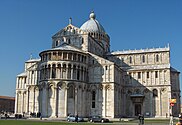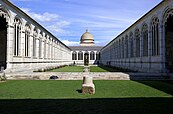
Back Pisa Afrikaans Pisa ALS ፒዛ፣ ጣልያን Amharic Pisa AN بيزا Arabic بيزا ARZ Pisa AST Pisa AVK Piza Azerbaijani پیزا AZB
Pisa | |
|---|---|
| Comune di Pisa | |
Historic centre of Pisa on the Arno | |
| Coordinates: 43°43′N 10°24′E / 43.717°N 10.400°E | |
| Country | Italy |
| Region | Tuscany |
| Province | Pisa (PI) |
| Frazioni | Calambrone, Coltano, Marina di Pisa, San Piero a Grado, Tirrenia |
| Government | |
| • Mayor | Michele Conti |
| Area | |
• Total | 185 km2 (71 sq mi) |
| Elevation | 4 m (13 ft) |
| Population (July 31, 2023)[2] | |
• Total | 98,778[1] |
| Demonym(s) | Pisano Pisan (English) |
| Time zone | UTC+1 (CET) |
| • Summer (DST) | UTC+2 (CEST) |
| Postal code | 56121–56128 |
| Dialing code | 050 |
| ISTAT code | 050026 |
| Patron saint | San Ranieri |
| Saint day | June 17 |
| Website | Official website |
Pisa (/ˈpiːzə/ PEE-zə; Italian: [ˈpiːza] ⓘ or [ˈpiːsa][3]) is a city and comune (municipality) in Tuscany, central Italy, straddling the Arno just before it empties into the Ligurian Sea. It is the capital city of the Province of Pisa. Although Pisa is known worldwide for its leaning tower, the city contains more than twenty other historic churches, several medieval palaces, and bridges across the Arno. Much of the city's architecture was financed from its history as one of the Italian maritime republics.
The city is also home to the University of Pisa, which has a history going back to the 12th century, the Scuola Normale Superiore di Pisa, founded by Napoleon in 1810, and its offshoot, the Sant'Anna School of Advanced Studies.[4]
- ^ "Statistiche demografiche ISTAT". demo.istat.it.[permanent dead link]
- ^ "Popolazione Residente al 1° Gennaio 2018". Italian National Institute of Statistics. Retrieved March 16, 2019.
- ^ "DiPI Online". Dizionario di Pronuncia Italiana (in Italian). Retrieved December 26, 2020.
- ^ Scuola Superiore Sant'Anna di Pisa Archived January 1, 2016, at the Wayback Machine Information statistics










